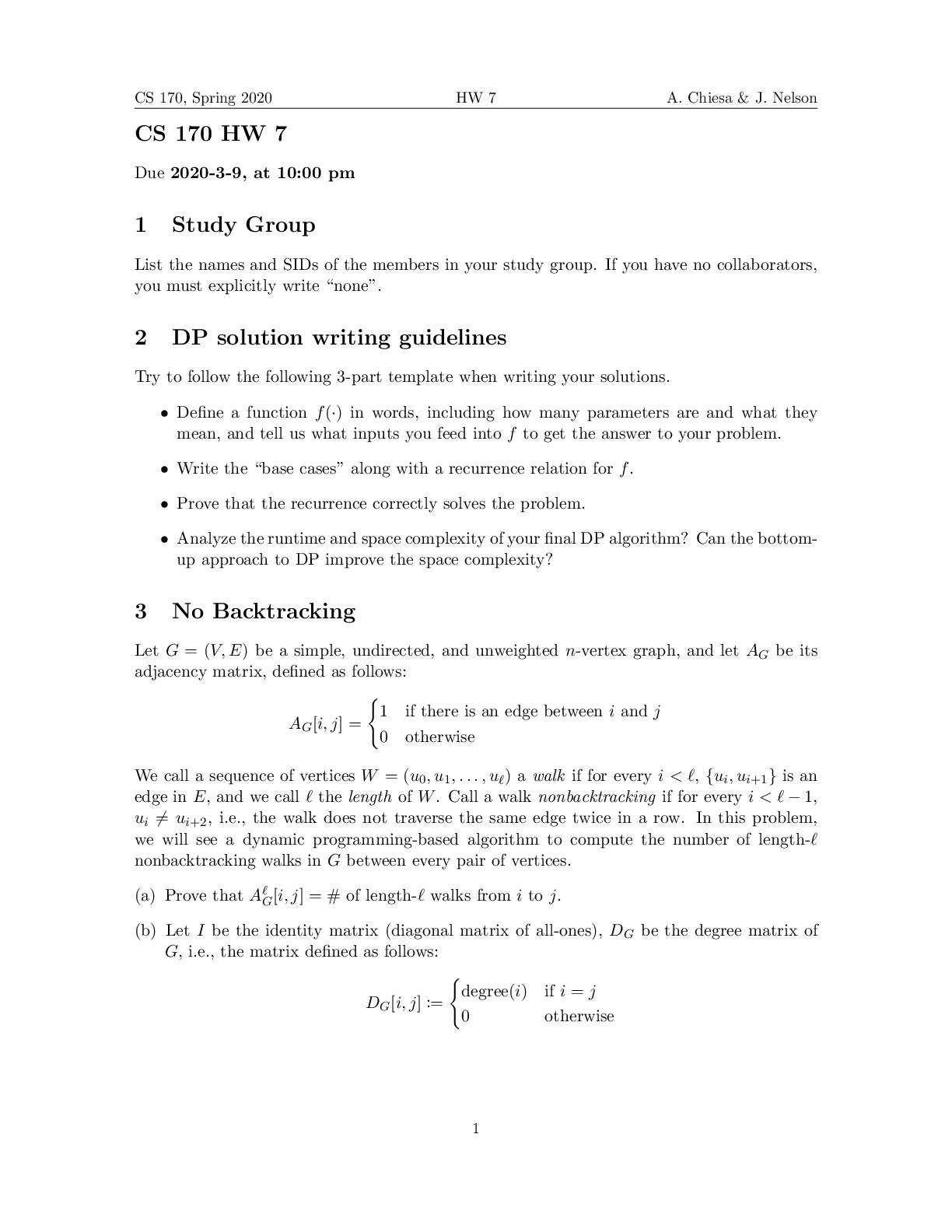Mathematics > QUESTIONS & ANSWERS > University of California, Berkeley - CS 70 hw3-sol. CS 70 Discrete Mathematics and Probability Theor (All)
University of California, Berkeley - CS 70 hw3-sol. CS 70 Discrete Mathematics and Probability Theory. Fall 2019. Homework 3. Solutions.
Document Content and Description Below
CS 70 Discrete Mathematics and Probability Theory Fall 2019 Alistair Sinclair and Yun S. Song HW 3 Note: This homework consists of two parts. The first part (questions 1-6) will be graded and will... determine your score for this homework. The second part (questions 7-9) will be graded if you submit them, but will not affect your homework score in any way. You are strongly advised to attempt all the questions in the first part. You should attempt the problems in the second part only if you are interested and have time to spare. Part 1: Required Problems 1 Degree Sequences The degree sequence of a graph is the sequence of the degrees of the vertices, arranged in descending order, with repetitions as needed. For example, the degree sequence of the following graph is (3;2;2;2;1). For each of the parts below, determine if there exists a simple undirected graph G (i.e. a graph without self-loops and multiple-edges) having the given degree sequence. Justify your claim. (a) (3;3;2;2) (b) (3;2;2;2;2;1;1) (c) (6;2;2;2) (d) (4;4;3;2;1) Solution: 2 Bipartite Graphs An undirected graph is bipartite if its vertices can be partitioned into two disjoint sets L, R such that each edge connects a vertex in L to a vertex in R (so there does not exist an edge that connects two vertices in L or two vertices in R). (a) Suppose that a graph G is bipartite, with L and R being a bipartite partition of the vertices. Prove that ∑ v2L deg(v) = ∑ v2R deg(v). (b) Suppose that a graph G is bipartite, with L and R being a bipartite partition of the vertices. Let s and t denote the average degree of vertices in L and R respectively. Prove that s=t = jRj=jLj. (c) The double of a graph G consists of two copies of G with edges joining the corresponding “mirror” vertices. More precisely, if G = (V;E), where V = fv1;v2;:::;vng is the set of vertices and E the set of edges, then the double of the graph G is given by G1 = (V1;E1), where V1 = fv1;v2;:::;vn;v01;v02;:::;v0ng; and E1 = E [ f(v0i;v0j)j(vi;vj) 2 Eg [ f(vi;v0i);8ig: Here is an example, CS 70, Fall 2019, HW 3 2 Draw the double of the following graph: (d) Now suppose that G1 is a bipartite graph, G2 is the double of G1, G3 is the double of G2, and so on. (Each Gi+1 has twice as many vertices as Gi). Show that 8n ≥ 1, Gn is bipartite. Hint: Use induction on n. Solution: 3 Planarity and Graph Complements Let G = (V;E) be an undirected graph. We define the complement of G as G = (V;E) where E = f(i; j)ji; j 2 V;i 6= jg-E; that is, G has the same set of vertices as G, but an edge e exists is G if and only if it does not exist in G. (a) Suppose G has v vertices and e edges. How many edges does G have? (b) Prove that for any graph with at least 13 vertices, G being planar implies that G is non-planar. (c) Now consider the converse of the previous part, i.e., for any graph G with at least 13 vertices, if G is non-planar, then G is planar. Construct a counterexample to show that the converse does not hold. Hint: Recall that if a graph contains a copy of K5, then it is non-planar. Can this fact be used to construct a counterexample? Solution: 4 Eulerian Tour and Eulerian Walk (a) Is there an Eulerian tour in the graph above? If no, give justification. If yes, provide a counterexample. (b) Is there an Eulerian walk in the graph above? If no, give justification. If yes, provide a counterexample. (c) What is the condition that there is an Eulerian walk in an undirected graph? Briefly justify your answer. Solution: 5 Trees and Components (a) Bob removed a degree 3 node from an n-vertex tree. How many connected components are there in the resulting graph? Please provide an explanation. (b) Given an n-vertex tree, Bob added 10 edges to it and then Alice removed 5 edges. If the resulting graph has 3 connected components, how many edges must be removed in order to remove all cycles from the resulting graph? Please provide an explanation. Solution: 6 Hamiltonian decompositions of a complete graph (a) (Walecki’s Theorem) Let Kn be the complete graph on n vertices. (i) If n is an odd positive integer, then the edge set of Kn can be partitioned into x edgedisjoint Hamiltonian cycles (a Hamiltonian cycle is a cycle where each vertex appears exactly once). (ii) If n is an even positive integer, then the edge set of Kn can be partitioned into y edgedisjoint Hamiltonian cycles and one perfect matching (a perfect matching is a set of edges such that every vertex is a part of exactly one edge in the set). Assume the above theorem is true. What are x and y? (b) Give a partition of the edges of K5 with vertices f1;2;3;4;5g into edge-disjoint Hamiltonian cycles. (c) Give a partition of the edges of K6 with vertices f1;2;3;4;5;6g into edge-disjoint Hamiltonian cycles and a perfect matching. CS 70, Fall 2019, HW 3 7 Solution: Part 2: Optional Problems 7 Planarity Consider graphs with the property T: For every three distinct vertices v1;v2;v3 of graph G, there are at least two edges among them. Prove that if G is a graph on ≥ 7 vertices, and G has property T, then G is nonplanar. Solution: 8 Connectivity Consider the following claims regarding connectivity: (a) Prove: If G is a graph with n vertices such that for any two non-adjacent vertices u and v, it holds that degu+degv ≥ n-1, then G is connected. [Hint: Show something more specific: for any two non-adjacent vertices u and v, there must be a vertex w such that u and v are both adjacent to w.] (b) Give an example to show that if the condition degu + degv ≥ n - 1 is replaced with degu + degv ≥ n-2, then G is not necessarily connected. (c) Prove: For a graph G with n vertices, if the degree of each vertex is at least n=2, then G is connected. CS 70, Fall 2019, HW 3 9 (d) Prove: If there are exactly two vertices with odd degrees in a graph, then they must be in the same connected component (meaning, there is a path connecting these two vertices). [Hint: Proof by contradiction.] 9 Hypercube Routing Recall that an n-dimensional hypercube contains 2n vertices, each labeled with a distinct n bit string, and two vertices are adjacent if and only if their bit strings differ in exactly one position. (a) The hypercube is a popular architecture for parallel computation. Let each vertex of the hypercube represent a processor and each edge represent a communication link. Suppose we want to send a packet from vertex x to vertex y. Consider the following “left-to-right bit-fixing” algorithm: In each step, the current processor compares its address to the destination address of the packet. Let’s say that the two addresses match up to the first k positions (reading the bits from left to right). The processor then forwards the packet and the destination address on to its neighboring processor whose address matches the destination address in at least the first k +1 positions. This process continues until the packet arrives at its destination. Consider the following example where n = 4: Suppose that the source vertex is (1001) and the destination vertex is (0100). Give the sequence of processors that the packet is forwarded to using the left-to-right bit-fixing algorithm. CS 70, Fall 2019, HW 3 10 (b) The Hamming distance H(x;y) between two n-bit strings x and y is the number of bit positions where they differ. Show that for an arbitrary source vertex and arbitrary destination vertex, the number of edges that the packet must traverse under the left-to-right bit-fixing algorithm is the Hamming distance between the n-bit strings labeling source and destination vertices. (c) There is another famous graph, called the butterfly network, which is another popular architecture for parallel computation. You will see this network in CS 170 in the context of circuits for implementing the FFT (fast fourier transform). Here is a diagram of the butterfly network for n = 3. In general, the butterfly network has (n + 1) • 2n vertices organized into n + 1 columns of 2n vertices each. The vertices in each column are labeled with the bit strings in f0;1gn, and all vertices in the same row have the same label. The source is on the leftmost column and the destination is on the right. It turns out the n-butterfly network is equivalent to the n-dimensional hypercube unrolled into n left-to-right bit-fixing steps. On the graph below, label the vertices in the graph explicitly and trace the path from source x = (110) to destination y = (011). Convince yourself that the left to right paths in the butterfly network are indeed equivalent to the hypercube routing obtained by the left-to-right bit-fixing algorithm. [Show More]
Last updated: 2 years ago
Preview 1 out of 12 pages

Buy this document to get the full access instantly
Instant Download Access after purchase
Buy NowInstant download
We Accept:

Reviews( 0 )
$12.00
Can't find what you want? Try our AI powered Search
Document information
Connected school, study & course
About the document
Uploaded On
Mar 09, 2021
Number of pages
12
Written in
Additional information
This document has been written for:
Uploaded
Mar 09, 2021
Downloads
0
Views
122






















.png)
.png)
.png)

